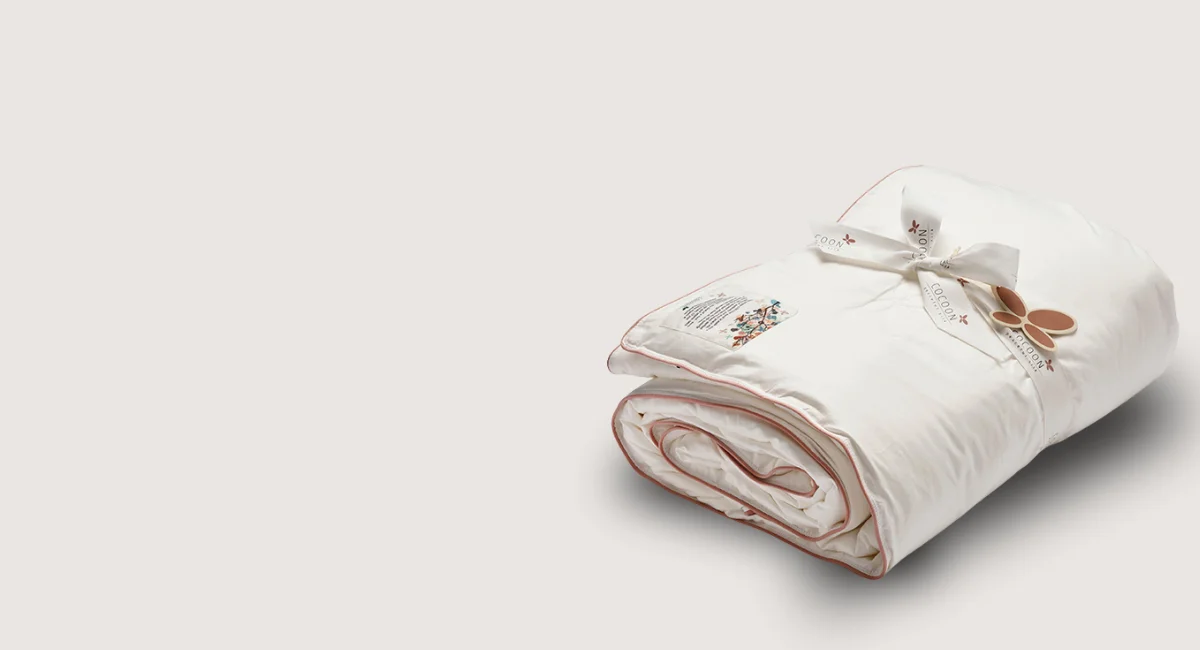We have a huge selection of organic duvets for you and your family. Sustainable and natural duvets.
And it can therefore be quite a task to get an overview of all our Cocoon duvets and what each of them can do.
That is why we have created this duvet guide for you, so that you can read a little about the different options and find the duvet that suits you best.
Common to all our duvets is that they are breathable and temperature regulating. And then they are made with great consideration for both people, animals and the environment in all production processes.
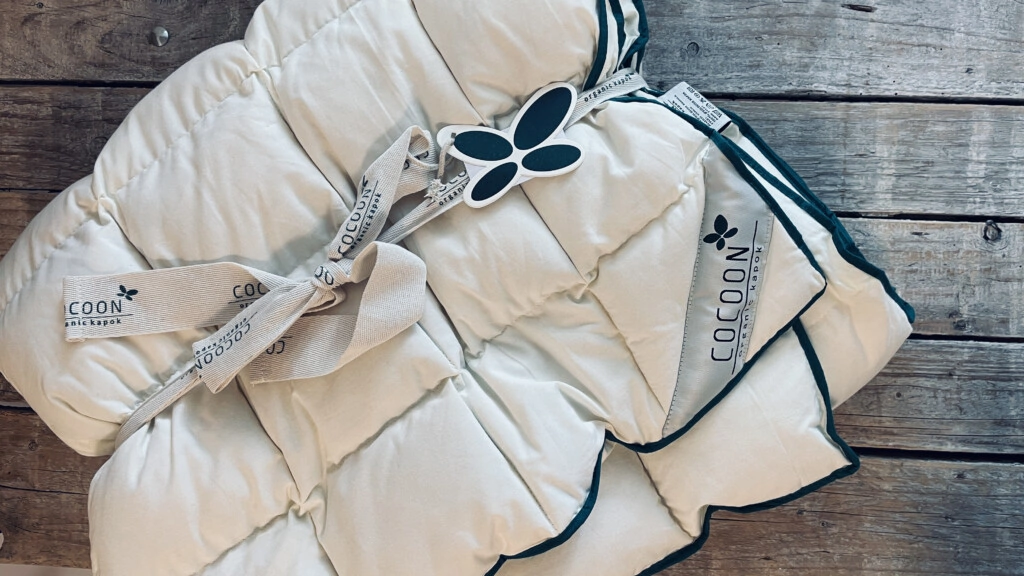
The best of kapok duvets
A kapok duvet is a very special duvet. And made of a very special fiber.
Kapok is a silky soft natural fiber that comes from the Ceiba Pentranda kapok tree. Kapok trees grow wild in the tropical rainforests. The trees can grow up to 70 meters high.
The kapok tree grows seed pods, which contain the kapok fiber itself. The kapok fiber has lots of small voids and a thin layer of wax around it that makes it water-repellent. The cavities in the fiber make it extremely breathable and temperature-regulating. It wicks moisture away from your body so you stay dry through the night. In that respect, the fiber is very similar to wool – simply as a pure plant fiber.
Advantages of a kapok duvet:
- The kapok duvet regulates your body temperature and conducts moisture away
- The duvet is antibacterial and hypoallergenic
- The kapok duvet is breathable and a massive duvet that provides security
- The kapok duvet can be used in both summer and winter
- The duvet is sustainably produced by the local population in India
- The kapok duvet should not be washed, as house dust mites cannot live in it
- A kapok duvet is a 100% vegan duvet
The kapok duvet is available both as a ordinary year-round duvet and as a summer duvet. The summer duvet is extra thin and suits the warm summers, or for those of you who feel extra hot at night.
Kapok duvets for children
Kapok duvets are for everyone! But young children in particular have a really hard time regulating their own body temperature. Therefore, it can be a really good idea with a kapok baby duvet.
Because if your baby's duvet is too warm, the baby cannot simply kick the duvet off. The kapok duvet, on the other hand, will ensure that your baby can get rid of the heat when it sleeps.
For slightly older children, a kapok junior dyne will also be a great choice.
Wash and maintain your kapok duvet
As a general rule, your kapok duvet should not be washed. The kapok fiber contains a bitter substance that house dust mites cannot live in. Therefore, it is actually just about trying to take good care of the natural fiber as it is.
However, if there has been an accident of some kind, it is of course possible to wash it.
You should wash the duvet alone at 40 degrees. However, it is also possible to wash at 60 degrees.
Choose as short a washing program as possible. The kapok fiber must not be wet for too long.
Choose a strong spin so that you get as much water out of the duvet as possible. Drive if necessary an additional centrifugation afterwards.
Use a mild detergent without enzymes and bleach. For example this effective detergent from Byoms, which also contains healthy probiotic bacteria.
When the kapok duvet is washed, it must be dried immediately. The fiber cannot tolerate being wet for very long.
Dry the kapok duvet alone in the tumble dryer. We recommend that you dry with tørrebolde so that the kapok fiber can be distributed as best as possible. Select a time-controlled program on medium heat. Dry for 30 minutes at a time and watch the duvet continuously. When the duvet is slightly damp, you can take it out and let it dry completely in a warm place.
Be careful not to dry your kapok duvet for too long in the dryer, as this can reduce the fiber's properties and lifespan.
See all our kapok duvets here and below.
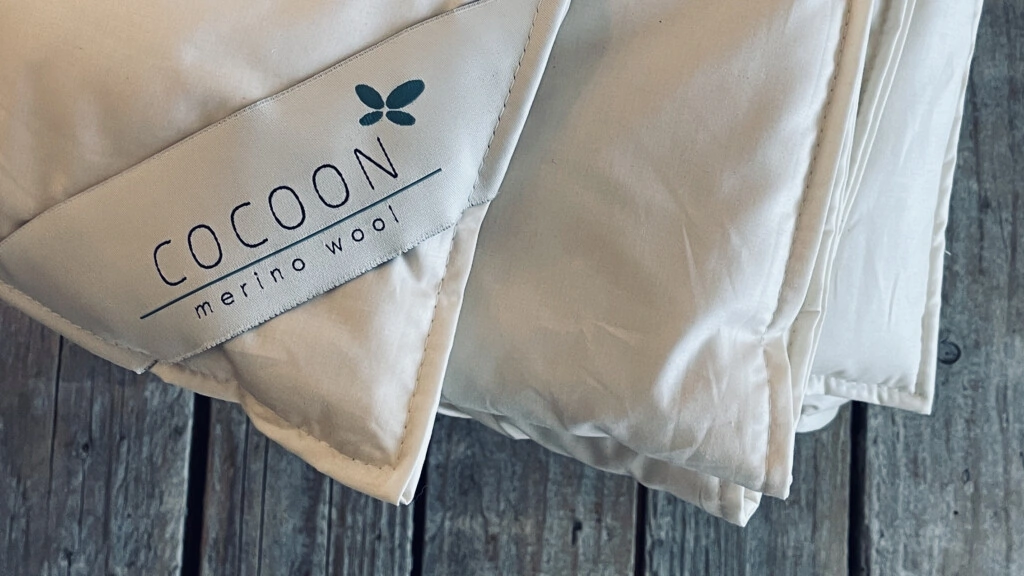
The best of wool duvets
Wool is a super effective temperature regulating material. Wool transports moisture away from your body if you get too hot. And uses your body heat to ensure you don't freeze.
These are some pretty unique features in a bed environment where you don't necessarily detect your body temperature during the night.
Advantages of a wool duvet:
- The wool duvet regulates your body temperature
- It is breathable and truly a luxury duvet to sleep with
- The wool duvet can be used in both summer and winter
- It is antibacterial. The lanolin in the wool does the magic here.
- The wool duvet is produced in Europe
- It requires no maintenance, as house dust mites cannot live in it
All wool duvets are available in 3 different thicknesses.
Light is for you who feel hot at night – year round
Medium is for you who need a cozy duvet that you can use all year round
Heavy is for you who freeze at night and maybe also sleep in a cool room
And then there is actually also a wool summer duvet, which is extra cool and for you who feel extra warm at night and/or sleep in a warm room.
Wool duvets and animal welfare
Wool is gold – but only from sheep with a good life
Conventional merino wool originates in many cases from Australia and Australian-bred sheep.
Here the sheep are rarely treated well, which I have written a sad story about just here.
But it certainly doesn't have to be that way. Because organic sheep have completely different conditions.
And the sheep that have given their wool to our Cocoon wool duvets live freely in the Spanish mountains.
They are rarely cut because the hairs have to be long for the down. And when they are cut, it is in a fair and proper way. The shearing is also necessary for the sheep, who otherwise get far too hot in the summer. And the remaining product can be used appropriately for duvets:-)
Animal welfare is an IMPORTANT thing to prioritize when we take in products here at the Ökofamilien. And the same is true for our supplier Cocoon.
You can therefore be absolutely sure that the sheep who have given their coat to your duvet have a good sheep life.
Wash and maintain your wool duvet
How should you maintain a wool duvet?
We often get questions about the maintenance of wool duvets.
Because we have been told for many years that we must wash our duvets 4 times a year to keep house dust mites down.
But this does not apply to wool duvets. Because house dust mites cannot live in the lanolin that the wool contains.
That is why you should not actually wash your wool duvet. On the contrary.
The lanolin keeps the duvet fresh, antibacterial and free from house dust mites.
On the other hand, it is a super good ideaé to air it once in a while. And it is extra effective in freezing weather:-)
However, if an accident occurs, you can wash the wool duvet.
It must be washed on a wool program and with max. 800 revolutions. The duvet should be washed with a lanolin-containing detergent such as dette, as the lanolin will otherwise be quietly washed out of the duvet. Alternatively, you can also rinse the duvet under a shower and spin it in the washing machine:-)
The wool duvet must then lie dry.
Washing a wool duvet is, however, at your own risk. Cocoon Company does not recommend it, as some washing machines can be too harsh on the duvet.
See all our wool duvets here and below.
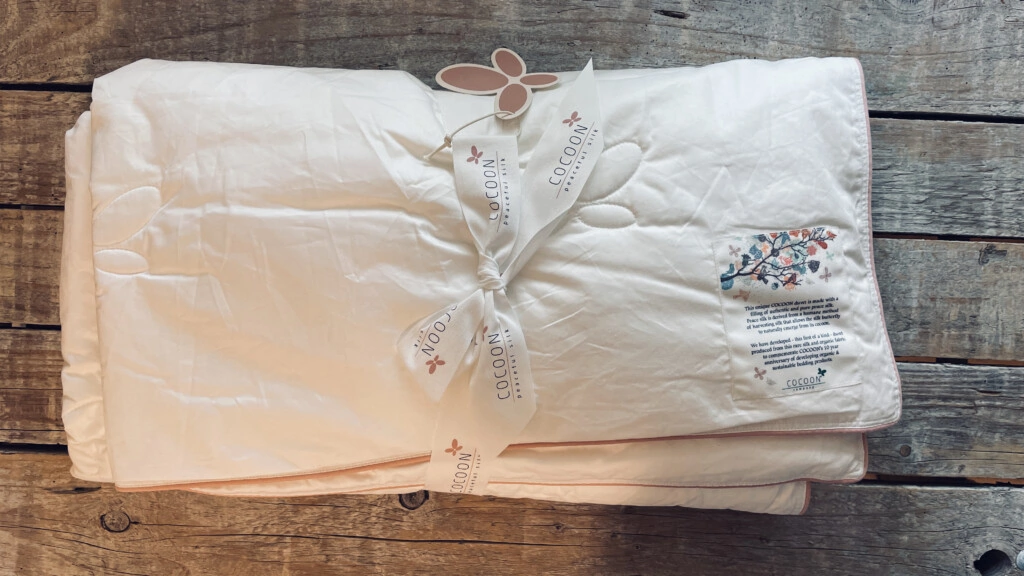
The best of silk duvets
A silk duvet is a very special duvet. It is light and airy, but warm and insulating.
The silk duvet is a luxury duvet beyond the ordinary.
With a silk duvet you are sure not to get too cold or too hot during the night. And the duvet takes up almost nothing.
Our Cocoon silk duvets are completely unique because they are made from a Mulberry Peace Silk that does away with years of barbaric production methods and instead takes into account the silkworms in the process.
Many consider silk duvets a summer duvet, but it is warm enough that you can use it all year round.
Advantages of a silk duvet
- A silk duvet is heat regulating and breathable
- The duvet is also hypoallergenic and resistant to house dust mites
- The silk duvet can be used in both summer and winter
- The silk duvet requires no maintenance or regular washing.
- A Cocoon silk duvet is a sustainable silk duvet that attaches great importance to animal welfare and the survival of the silkworm.
Silk duvets and animal welfare
Do you know how silk is usually produced?
You will be SO surprised. At least we did.
Silk comes from the silkworm, which pupates and in the process produces long silk threads around itself. To release the silk for the production of clothes or duvets, the larvae are usually boiled alive. It gives long silk threads that you want.
And although Cocoon and we have long wanted a silk duvet in the range, the traditional form of production is not something we want to support. But Cocoon now finally has a duvet that is humanely produced for the silkworm.
With the Peace Silk concept, the silkworm is not boiled alive, but instead pulled out of its pupa in a completely humane way. The caterpillar develops further among organic mulberry leaves and flies from there as a silk butterfly.
The silk threads are thus cut when the larva is to be released, but this does not matter when the silk is to be used for duvets.
With Cocoon's silk duvets, you can therefore be sure that the caterpillars that supplied silk to your duvet have survived and ended up as butterflies.
Wash and maintain your silk duvet
A silk duvet should not be washed.
It doesn't matter in everyday life, as house dust mites and mold cannot live in the silk.
However, if there has been an accident and there is nothing else to do, the silk duvet can be rinsed under the shower or in the bathtub and then laid dry.
Alternatively, the silk duvet can be sent to the dry cleaners.
In addition, you can refresh the duvet regularly with Byoms lugtfjerner. It removes odor and possibly bacteria that might be on the outside of the duvet.
See all our silk duvets here and below.
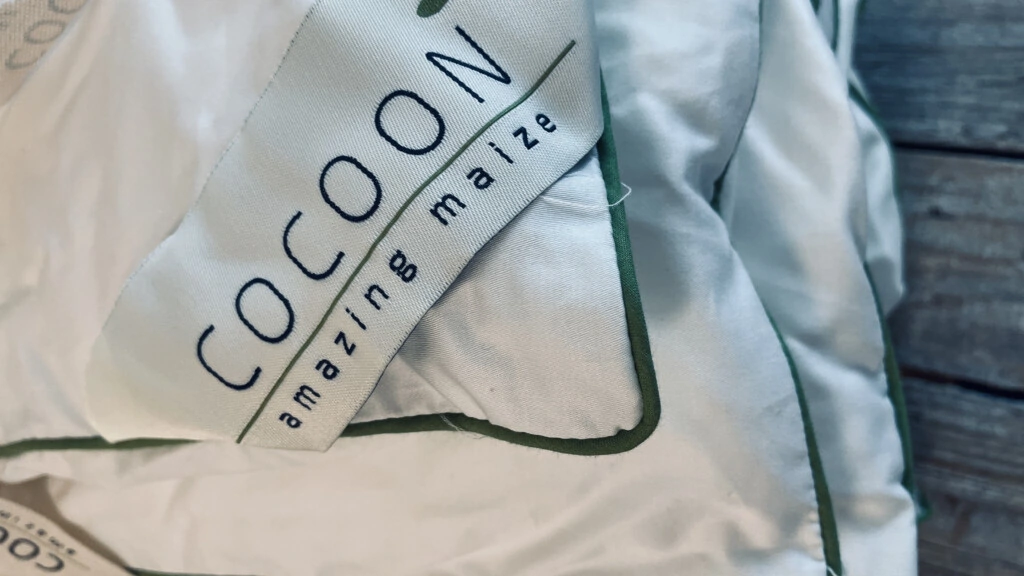
The best of cornfiber duvets
A cornfiber duvet is completely different than you might expect. It is the most delicious soft fiber you can imagine.
The cornfiber duvet is vegan and biodegradable and has the same special properties as our other natural duvets – it is both breathable and temperature-regulating.
This means you can get rid of the heat and humidity at night.
The structure of the corn fiber is made like wool. It is hollow, which is what gives the corn fiber its temperature-regulating properties.
The cornfiber duvet is made from lactic acid, which is extracted from the plant sugar in corn when they ferment. The fiber therefore only contains biodegradable materials.
Advantages of a cornfiber duvet
- The cornfiber duvet is breathable
- The duvet is temperature regulating and directs moisture away from your body
- A cornfiber duvet is vegan and biodegradable
- The cornfiber duvet is airy and delicious and most reminiscent of a down comforter
- The cornfiber duvet is a warm duvet that you can use all year round.
Wash your cornfiber duvet
Your cornfiber duvet is only made from natural materials and no added color or harmful chemicals. Therefore, it is not necessary to wash your duvet before use.
The cornfiber duvet can easily be washed, but we recommend that you wash the duvet as rarely as possible. Washing wears down the fiber.
The cornfiber duvet can be washed at 40 degrees in the washing machine. 60 degrees can also be done.
Use as few revolutions as possible to avoid tangling the fiber.
However, should the fibers get tangled together, you can easily separate them again.
When washing, you should use a mild detergent. We recommend this from Byoms, which also contains healthy probiotic bacteria.
Dry the cornfiber duvet at medium heat in the tumble dryer. Feel free to use wool dryer balls for the purpose, so that the fiber is well distributed in the drying process.
See all our cornfiber duvets here or below.
Which duvet is right for you?
We are all different. Also when we sleep.
Some are very hot at night and others freeze very easily.
Some sleep with the window open and others don't.
That is why it makes sense to choose the duvet that suits you exactly. Because even though all our duvets are breathable and temperature regulating, there is a difference in how much of your body heat the duvet can use to warm you up. The thicker the duvet, the more body heat it distributes and keeps it on.
Below you can see an overview of duvet types and temperatures. It can hopefully guide you to the right choice of duvet.
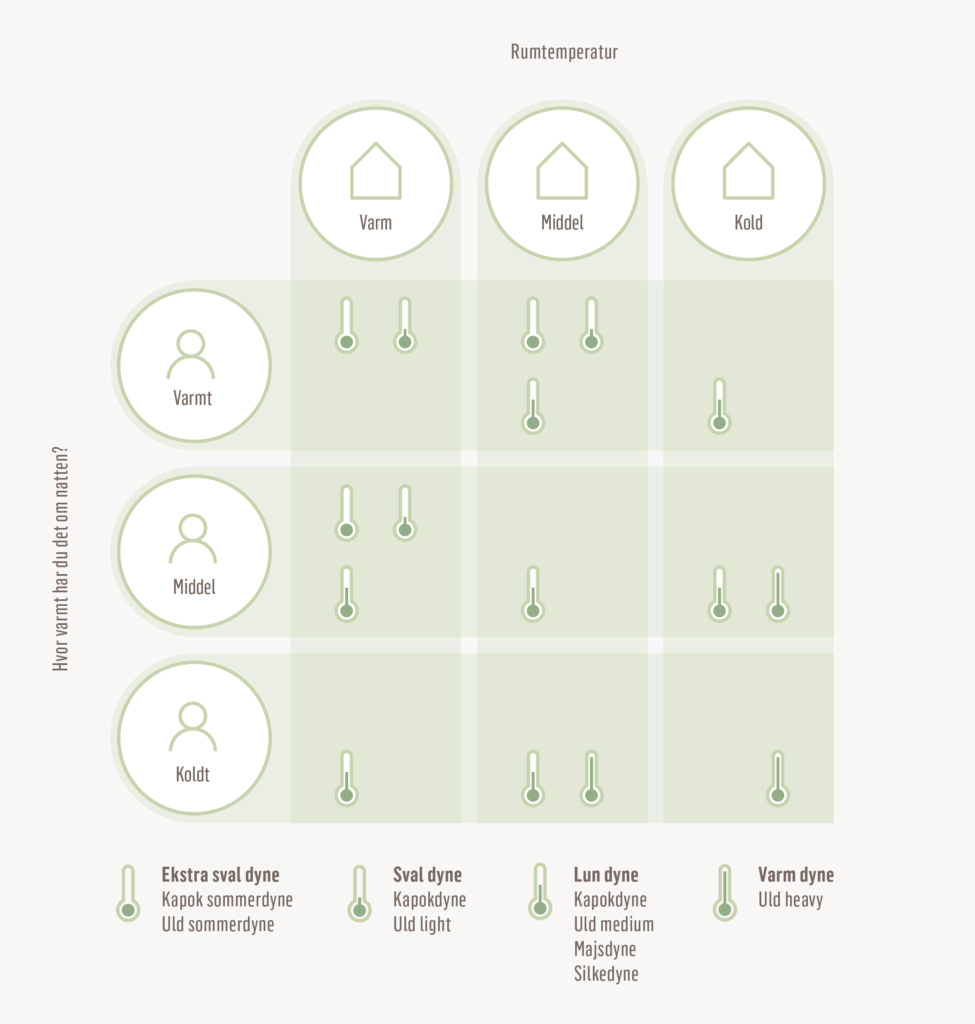
There is a difference in the feel of the duvet
Now you have read a little about our different Cocoon duvets. They are all fantastic, but of course different.
Therefore you get just a little input into the feel of the duvet as well.
- A Kapok duvet is a compact duvet. It reminds a little bit of an old-fashioned thick cotton blanket. The kapok duvet provides weight and security and is really nice to sleep with. Over time, the kapok duvet will become softer. So finally use it as much as possible if you want to speed up that process.
- A wool duvet is an insanely luxurious duvet. In every way. It is airier than a kapok duvet, but is also a compact duvet.
- A silk duvet is a light and airy duvet. You might be surprised at how little it takes up and weighs. But it is a year-round duvet that you can also use in winter.
- A cornfiber duvet is a soft and airy duvet. It is the duvet that comes closest to the same feeling as a down comforter. The duvet falls nicely around the body.
If you have any questions about our duvets, please contact us. We are ready at hej@okofamily.com


